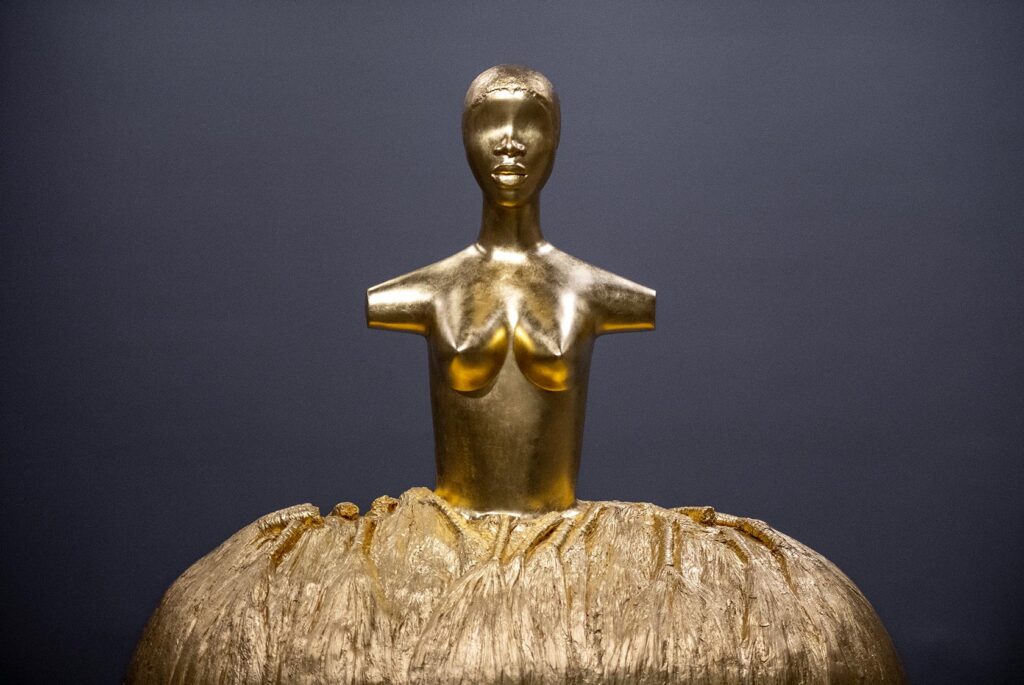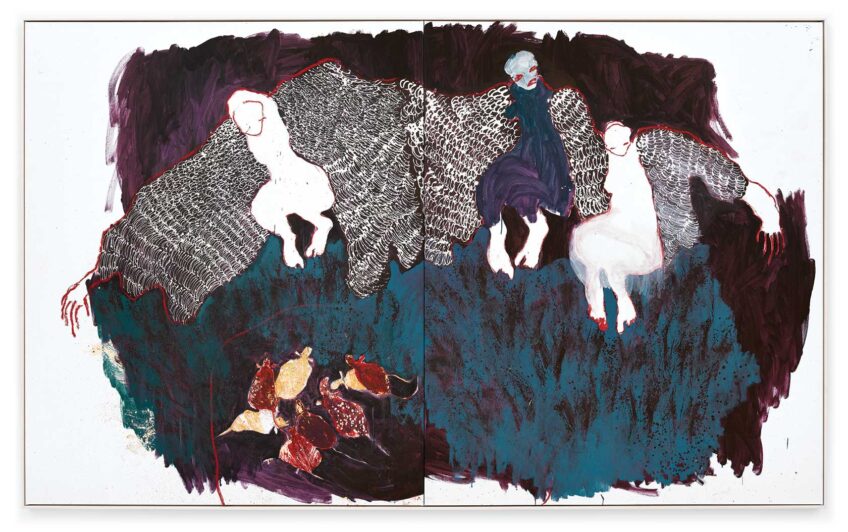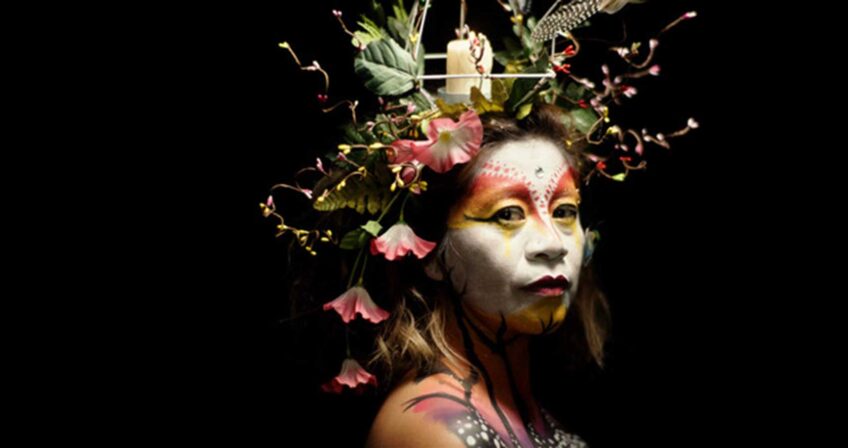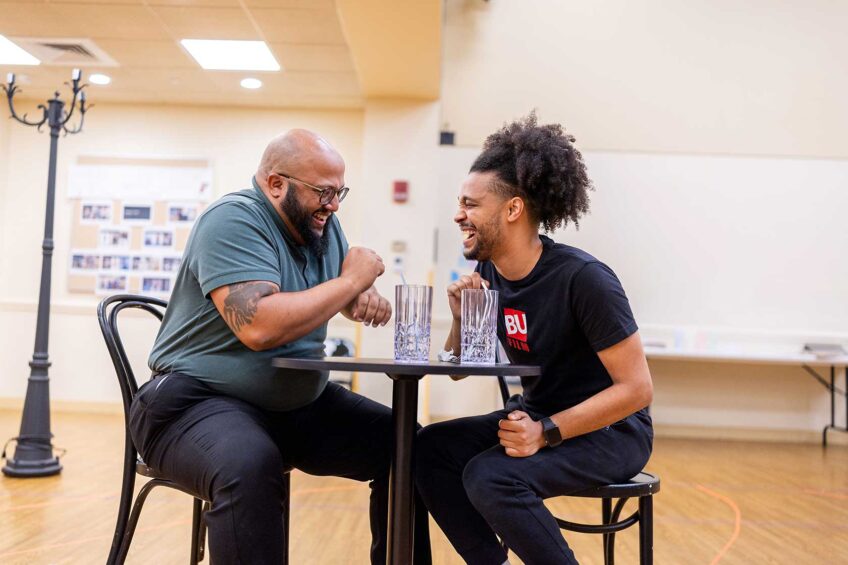
The latest tower to rise along Boston Harbor is neither a condo complex nor a hotel. Instead, it is a commanding, 24-foot-high sculpture in black bronze that stands at the entrance of the Institute of Contemporary Art Boston.
Entitled “Satellite” (2022), the four-legged figure, with a massive satellite cup for its head, is part of the first museum survey devoted to Simone Leigh, 56, whose works honor the power of Black women as creators of their own lives and stories. Like other works on view, “Satellite” is a kind of conduit, communicating the experience of Black women throughout the diaspora.
Accompanied by the first comprehensive monograph of Leigh’s work, the exhibition, entitled “Simone Leigh,” was organized by the ICA/Boston’s chief curator, Eva Respini, and Anni A. Pullagura, curatorial assistant. On view at the ICA/Boston through Sept. 4, 2023, the exhibition will tour to the Hirshhorn Museum and Sculpture Garden in Washington, D.C. from November 2023 to March 2024 and then receive a joint presentation at the Los Angeles County Museum of Art and the California African American Museum from June 2024 to January 2025.

Simone Leigh, “Satellite,” 2022. Bronze. Installation view, the Institute of Contemporary Art/Boston, 2023. Courtesy the artist and Matthew Marks Gallery. PHOTOS: TIMOTHY SCHENCK, © SIMONE LEIGH
The survey includes some of the works in Leigh’s exhibition in the U.S. Pavilion at the 2022 Venice Biennale, where she was first Black woman to represent the U.S., chosen by ICA/Boston Director Jill Medvedow and Respini, who were the Pavilion’s 2022 co-commissioners. Leigh complemented her exhibition there, “Simone Leigh: Sovereignty,” with a three-day symposium on the agency and self-determination of Black women, convening hundreds of Black women scholars, writers, and artists.
At the Biennale, Leigh also received the Golden Lion, the event’s highest honor, for her sculpture at the entrance to the Arsenale, which exhibited works from more than 100 countries. The 16-foot black bronze sculpture, “Brick House,” a female figure whose skirt evokes a West African hut, stood from 2019 to 2021 in midtown Manhattan on the High Line, the pedestrian greenway along the Hudson River, as the park’s first large-scale sculpture.
Major museums collect and exhibit works by Leigh, whose awards include the Studio Museum of Harlem’s 2017 Joyce Alexander Wein Artist Prize and the 2019 Hugo Boss Prize.

Simone Leigh, “Jug” (detail), 2019. Bronze. Collection of Charlotte and Herbert S.Wagner III. PHOTOS: TIMOTHY SCHENCK, © SIMONE LEIGH
Rendering potent works in salt-glazed ceramics that draw upon artistic traditions and rituals of Africa and the African diaspora, Leigh has for decades chosen a medium once dismissed by the art world as a tool of hobbyists or studio potters. Working early in her career at her kitchen table, and now in a warehouse-sized studio in Brooklyn equipped with a 6-foot-high salt-and-soda kiln, Leigh begins her sculptures as clay models, which she fashions by hand.
“Simone Leigh” presents 29 works, almost all made from 2011 to 2023. Along with the sculptures, the exhibition includes a mural-size photograph and three short films.
Dominating the first gallery is a dazzling female figure in gilded bronze, “Cupboard” (2022), with a voluminous dome-shaped skirt that evokes a traditional African dwelling. Sharing the room is a slender, tubular figure in black bronze, “Sentinel IV” (2020), which in its more than 10 feet of height includes smooth buttocks, small breasts, and a bowl-like head.
Guardian figures in other galleries include a pair of stoneware sphinxes — sleek, muscular lionesses endowed with thick curving tails. And an 11-foot-high version of “Cupboard” in a later gallery combines two of Leigh’s signature motifs — raffia skirts and cowrie shells, once a form of currency in African cultures. Instead of a female torso, a courie shell is mounted on top of its giant dome of raffia.
Smaller works on view often have intricate embellishments. A porcelain and terracotta head is crowned by a tower of tiny rosettes. A head rendered in mustard yellow stoneware is a showcase of intricately molded curls.
Sculptures in white stoneware stand among works with solid black glazes, such as the towering image of an introspective woman “Sharifa” (2022). Rendered in a glossy black sheen, the semi-figurative sculpture offers a naturalistic rendering of a woman’s body and facial features but extends to a superhuman 9-foot height.
Some busts demonstrate Leigh’s elegant take on stoneware face vessels, pottery jugs made by enslaved potters in the clay-rich Edgefield District of South Carolina for their own ritual use when not working on industrial production of pots for plantation owners. Unlike the originals, which show highly contorted human faces, Leigh’s are semi-abstract, minimalist works. An unmissable exhibition on view at the Museum of Fine Arts Boston through July 9, entitled “Hear Me Now,” presents works by these 19th-century potters alongside those of contemporary artists, including Leigh.

Simone Leigh, “Last Garment” (2022). Bronze, steel, metal, filtration pump and water. Courtesy the artist and Matthew Marks Gallery. PHOTO: SUSAN SACCOCCIA
In “Breakdown” (2011), a nine-minute video by Leigh and Liz Magic Laser that unfolds in the balcony of a church, mezzo-soprano Alicia Hall Moran becomes a living face vessel in her wild, humorous portrayal of a woman in meltdown. Moran twists her beautiful face into grotesque shapes while her shimmering voice quakes with free-form scat vocals venting an inner storm.
Leigh’s installation “Last Garment” (2022) concludes the exhibition with grandeur. The artist takes a 19th-century tourist trope — a popular Jamaican postcard showing a laundress washing clothes in a river — and transcends it by recasting the scene as a tribute. Against an expansive view of Boston Harbor, Leigh’s naturalistic bronze sculpture of the laundress, whose hair is adorned with 800 tiny rosettes, stands in a monumental pool gazing at her reflection.






